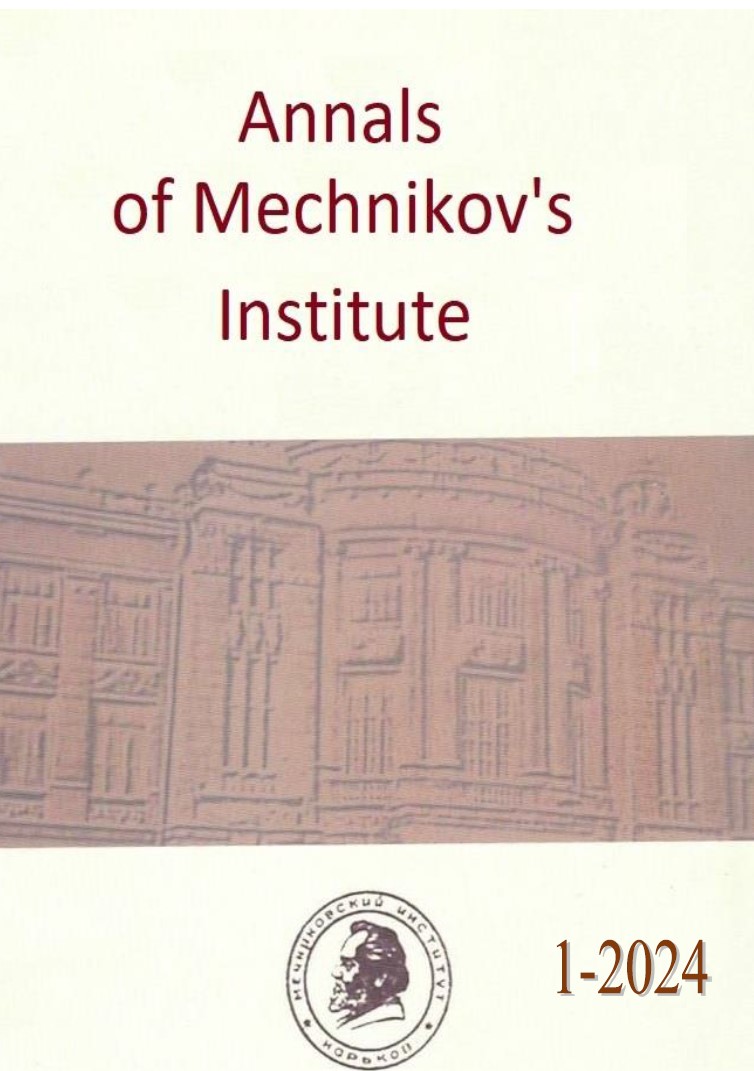Вибір антимікробних речовин у складі крему ректального з густим екстрактом Моркви посівної та рутином
DOI:
https://doi.org/10.5281/zenodo.10838408Ключові слова:
ректальний крем, антимікробні консерванти, антимікробна активністьАнотація
Вступ. Синтетичні консерванти здатні значно продовжити термін придатності швидкопсувного продукту, хоча вони мають багато побічних ефектів, які шкідливо впливають на здоров’я людини. Зважаючи на це це, існує сучасна тенденція на використання консервантів із натуральних рослинних продуктів. Згідно даних літератури природні речовини широко використовуються як ефективні консерванти. Регуляторними органами, що контролюють якість, безпеку та ефективність лікарських засобів приділяється велика увага саме природним речовинам, що можуть використовуватися у фармацевтичній промисловості, що дозволить знизити ризик виникнення побічних ефектів..
На кафедрі заводської технології ліків НФаУ, м. Харків розробляється ректальний крем з густим екстрактом моркви посівної та рутином. Відомо, що властивості флавонолів та їх глікозидів активно вивчаються щодо антимікробної активності Встановлено, що рутин пригнічує зростання бактерій Escherichia coli, інгібує життєдіяльність Proteus vulgaris, Shigella sonnei та Klebsiella sp., має антимікробну активність проти Pseudomonas auruginosssa та Bacillus subtilis. Завдяки інгібування ДНК-ізомерази IV пригнічує активність E. coli. Рутин синергічно посилює антибактеріальну активність інших флавоноїдів проти Bacillus cereus і Salmonella enteritidis, має протигрибкову активність проти штаму Candida gattii з мінімальною інгібіторною концентрацією 60 мкг/мл. З огляду цього, було досліджено зразки ректального крему з рутином та густим екстрактом моркви без та з додаванням різних антимікробних агентів.
Матеріали та методи. Об’єктами дослідження були: Microcare PЕ (Phenoxyethanol) 1%, Sharomix 702 (Dehydroacetic Acid, Benzoic Acid, Phenoxyethanol) (1,35%), Sharomix MCI II (Methylchloroisothiazolinone, Methylisothiazolinone and Benzyl Alcohol) 0,1%, Sharomix 300 (Ме, Pr- paraben, Bronopol, Phenoxyethanol) 0,7%, Sharomix Amplify AM-25 (Phenoxyethanol, Chlorphenesin, Caprylyl Glycol, Didecyldimonium chloride) 0,5%, Sharomix EG10 (EthylHexylGlycerin, Phenoxyethanol) 1,1%, SharoSENSE Plus 181 (Maltol, Polyquaternium-80) 0,5%, зразки крему з SharoSENSE Plus 181 та Sharomix Amplify AM-25 та без консервантів. Результати та обговорення. Визначено мінімальні інгібуючі концентрації досліджуваних консервантів для культури Escherichia Coliпроводились за допомогою методу серійних розведень. Проведено випробування ефективності антимікробних консервантів, перевірку стерильності живильних середовищ, розчинника та ростових властивостей живильних середовищ придатності методики визначення загального числа життєздатних клітин.
Досліджено ефективність SharoSENSE Plus 181 та Sharomix Amplify AM-25 у складі ректального крему. Встановлено відповідність отриманих результатів вимогам ДФУ до препаратів для ректального застосування. Враховуючи вимоги безпечності та економічності, фізико-хімічні властивості є SharoSENSE Plus 181. Як найбільш прийнятну концентрацію консерванту було обрано 0,5 %. Висновки. Встановлено, що найбільш ефективними виявилися SharoSENSE Plus 181 та Sharomix Amplify AM-25, які проявили інбігуючу дію за концентрації 480 ppm та 500 ppm відповідно. Встановлено, що живильні середовища відповідали за ростовими властивостями і витримували випробування на стерильність згідно з вимогами ДФУ 2.0, п. 2.6.12, а тест-мікроорганізми відповідали таксономічній характеристиці – морфологія колоній на середовищах та морфологія клітин під час мікроскопування були типовими для відповідного штаму. Враховуючи вимоги безпечності, економічності та фізико-хімічні властивості найбільш прийнятним консервантом обрано SharoSENSE Plus 181 у концентрації 0,5 %.
Ключові слова: ректальний крем, антимікробні консерванти, антимікробна активність
Посилання
Pawlowska A.M., Zannini E., Coffey A., Arendt E.K.. "Green preservatives": combating fungi in the food and feed industry by applying antifungal lactic acid bacteria. Adv Food Nutr Res. 2012. 66. Рю 217-238. doi: 10.1016/B978-0-12-394597-6.00005-7. PMID: 22909981.
Association for Human Pharmacology in the Pharmaceutical Industry conference 2022: impending change, innovations and future challenges. Mundy C, Bush J, Cheriyan J, Lorch U, Stringer S, Taubel J, Wydenbach K, Hardman TC. Front Pharmacol. 2023 Nov 2;14:1219591. doi: 10.3389/fphar.2023.1219591. eCollection 2023.
Dréno B., Zuberbier T., Gelmetti C., Gontijo G., Marinovich M. Safety review of phenoxyethanol when used as a preservative in cosmetics. J Eur Acad Dermatol Venereol. 2019. Nov; 33 Suppl 7. Р. 15-24. doi: 10.1111/jdv.15944. PMID: 31588615.
Frątczak A, Bylka W i Studzińska-Sroka E: Fenolokwasy – budowa, działanie biologiczne i znaczenie w kosmetologii. Polish Journal of Cosmetology 2015; 18(4): 270-274.
Parus A: Przeciwutleniające i farmakologiczne właściwości kwasów fenolowych. Postępy Fitoterapii 2013; 1: 48-53.
Supritha, P.; Radha, K.V. Estimation of phenolic compounds present in the plant extracts using high pressure liquid chromatography, antioxidant properties, and its antibacterial activity. Indian J. Pharm. Educ. Res. 2018, 52, 321–326.
Nguyen, T.L.A.; Bhattacharya, D. Antimicrobial Activity of Quercetin: An Approach to Its Mechanistic Principle. Molecules 2022, 27, 2494. https://doi.org/10.3390/molecules27082494
Cushnie T.P., Lamb A.J. Antimicrobial activity of flavonoids. Int J Antimicrob Agents. 2005. 26(5). Р. 343-56. doi: 10.1016/j.ijantimicag.2005.09.002.
Ganeshpurkar, A., Saluja, A. K., The Pharmacological Potential of Rutin, Saudi Pharmaceutical Journal, 2017. 25 (2). P. 149-164.
Borshchevskii, G. I., Railko, Z. O., Reida, V. P. Testing the effectiveness of antimicrobial preservatives of the drug "Efial" Annals of Mechnikov Institute. 2015. 1. R. 44-48
Antipenko, L., Rebets, O., Karnaukh, I., Antipenko, O., Kovalenko S. Step-by-step method of determining the minimum inhibitory concentration of a hydrophobic biologically active compound by the method of dilution with broth International scientific journal "Grail of Science. 2022. 17. Р. 468 – 474.
State Pharmacopoeia of Ukraine. SE "Ukrainian Scientific Pharmacopoeia Center for the Quality of Medicinal Products". 2nd edition. Kharkiv. State. "Ukrainian Scientific Pharmacopoeia Center for the Quality of Medicinal Products". 2015. Vol. 1. 1128 p.
EUCAST. European Committee on Antimicrobial Susceptibility Testing. Clinical breakpoints and dosing of antibiotics. 2022. Retrieved from https://eucast.org/clinical _breakpoints/.
Kowalska-Krochmal B., Dudek-Wicher R. The Minimum Inhibitory Concentration of Antibiotics: Methods, Interpretation, Clinical Relevance. Pathogens. 2021. 10(2). Р.165. doi: 10.3390/pathogens10020165.
EUCAST. MIC determination of non-fastidious and fastidious organisms. 2022. Retrieved from https://eucast.org/ast_of_bacteria/mic_determination/.
##submission.downloads##
Опубліковано
Як цитувати
Номер
Розділ
Ліцензія
Авторське право (c) 2024 Анали Мечниковського Інституту

Ця робота ліцензується відповідно до Creative Commons Attribution 4.0 International License.





